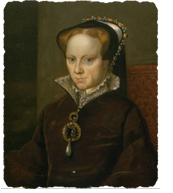

Mary was Queen from 1553 to 1558. When she died, Mary had no children to pass the crown to. Her half-sister, Elizabeth became Queen. Mary was buried in Westminster Abbey.
Mary inherited a Treasury that was in debt and a country facing severe economic difficulties. Successive debasements of the coinage during the reigns of Henry VIII and Edward VI had resulted in devaluation and a loss of confidence in the English currency. Plans were drawn up to reform the currency and withdraw the debased coins although these were not implemented during Mary’s reign. The Book of Rates was revised and a new edition published in 1558. This detailed the customs duties that were to be levied on imports and exports, the revenue from which went to the Crown.
During Mary’s reign there was a move to open up new trade routes and find new markets for English goods. The Muscovy Company was granted a Royal Charter in 1555 to establish a trading monopoly with Russia. It was one of the first major joint-stock companies to be granted a charter.
English merchants tried to break the Portuguese monopoly in the West African gold trade. In 1555 a London merchant, John Lok, brought a group of Africans (from modern day Ghana) to England to learn English so that they could return to West Africa and work as interpreters.
The Tudor era was a time of increasing population. There was economic depression with rising prices and rising unemployment. In 1555 persistent rainfall led to flooding which was then followed by a drought in the spring of 1556. This caused harvests to fail leading to a sharp rise in the price of wheat and starvation and famine. In 1558 a flu epidemic struck England leaving thousands dead.
Philip returned to England in March 1557. He left at the beginning of July having persuaded Mary to commit English forces to a war against France. Many on Mary’s Council had advised against it. War was expensive, trade with France would be disrupted and the marriage treaty had specified England was not to involve itself in any Habsburg wars. In January 1558 Calais, the last English possession in France was captured by the French. It was a humiliating defeat for England and added to the popular discontent that now surrounded Mary’s reign. Philip never returned to England.
Mary believed herself to be pregnant again. As childbirth was a potentially life threatening event, Mary wrote her will in March 1558. In it she named her unborn child as her heir with Philip to rule as Regent. However, once again the signs of pregnancy had been false. Mary frequently suffered from ill health but by the autumn of 1558 it was clear that the Queen was seriously ill. On the 28 October Mary amended her will stating that her successor should be according to the ‘Laws and Statutes of the Realm’, although no name was given.
At the beginning of November, knowing that she would never have her longed for Catholic heir, Mary named her sister Elizabeth as successor. Mary asked that Elizabeth would maintain the Catholic religion.
On the 17 November 1558, at the age of forty two, Queen Mary I died at St James’ Palace. Despite her wish to be buried next to her mother, Mary was buried on 14 December in Westminster Abbey, in Henry VII’s Lady Chapel.
The coffin of Elizabeth I was later placed on top of Mary’s. King James I of England commissioned a monument above the grave although it only shows an effigy of Elizabeth.
One of the Latin inscriptions reads “Partners both in throne and grave, here rest we two sisters, Elizabeth and Mary, in the hope of the Resurrection”.
Continue reading with these recommended books (paid links)
The Terrible Tudors: Misery Mary (The Horrible Histories Collection)
 |
 |
 |
